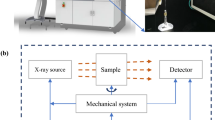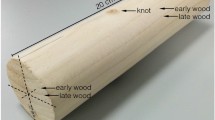Abstract
This study utilises Computer Tomography (CT-scanning) to characterize the capillary water uptake in wood specimens. CT-scanning makes it possible to study the capillary rise of water as a function of height in wood specimens after a specific exposure time. The study has also included the development of a theoretical model, which determines the capillary characteristics of wood in relation to its structure. The model developed was tested using experimental results, considering the capillary suction height and the water content change after a specific time as boundary values.
A comparison between the theoretical model and the experimental results shows that not all the cells in the wood samples take part in the capillary water transport. It also appears that there is a structural resistance to capillary flow.
Zusammenfassung
In dieser Studie wird mittels Computertomografie (CT-Messung) die kapillare Wasseraufnahme in Holzproben beschrieben. Dieses Verfahren ermöglicht es, die Höhe des kapillaren Wasseranstiegs in den Holzproben nach einer vorgegebenen Eintauchdauer zu untersuchen. Darüber hinaus wurde ein theoretisches Modell zur Bestimmung der kapillaren Eigenschaften von Holz in Abhängigkeit seiner Struktur entwickelt. Dieses Modell wurde anhand von Versuchsergebnissen geprüft, wobei die kapillare Saughöhe und die Änderung des Wassergehalts nach einer vorgegebenen Zeit als Zielwerte berücksichtigt wurden.
Ein Vergleich des theoretischen Modells mit den Versuchsergebnissen ergab, dass nicht alle Zellen in den Holzproben am kapillaren Wassertransport teilnehmen. Es hat sich auch gezeigt, dass es einen strukturbedingten Widerstand gegen die Kapillarströmung gibt.
Similar content being viewed by others
References
Bosshard HH (1974) Holzkunde Band I: Mikroskopie und Makroskopie des Holzes. Birkhäuser Verlag, Basel
Bao F, Siau J F, Avramidis S (1986) Permeability and capillary structure of Chinese woods. Wood Fiber Sci 18(2):220–227
Bao F, Lu J, Zhao Y (2001) Effect of boarded pit torus position on permeability in Chinese yezo spruce. Wood Fiber Sci 33(2):193–199
Ekström H (1989) Aspen (Populus tremula): Wood properties and utilisation. Swedish University of Agricultural Sciences, Uppsala, Report No. 207 (In Swedish with an English abstract)
Flaete PO, Eikenes B (2000) Osp som byggemateriale (Aspen as a construction material). Norwegian Institute for Forest Research, Report No. 6/00:1–29, (In Norwegian)
Fromm JH, Sautter I, Matthies D, Kremer J, Schumacher P, Ganter C (2001) Xylem water content and wood density in spruce and oak trees detected by high-resolution computed tomography. Plant Physiol 127:416–425
Hart CA, Thomas RJ (1967) Mechanism of bordered pit aspiration as caused by capillarity. Society of Wood Science and Technology, SWST research paper, No. 19
Johansson D, Sehlstedt-Persson M, Moren T (2006) Effect of heat treatment on capillary water absorption of heat-treated pine, spruce and birch. In proceedings of the 5th IUFRO Symposium Wood Structure and Properties 2006, September 3–6, Slovakia
Kohonen MM (2006) Engineered wettability in tree capillaries. Langmuir 22(7):3148–3153
Kollmann FFP, Côte WA Jr (1968) Principles of wood science and technology: I Solid Wood. Springer-Verlag, Berlin
Lancashire JR, Ennos AR (2002) Modelling the hydrodynamic resistance of bordered pits. J Exp Bot 53(373):1485–1493
Lindgren LO (1991) Medical CAT-scanning: X-ray absorption coefficients, CT-numbers and their relation to wood density. Wood Sci Technol 25:341–349
Lindgren O (1992) Medical CT-scanners for non-destructive wood density and moisture content measurements. Doctoral thesis, Sweden, Luleå University of Technology
Morén T (1993) Creep, deformation and moisture redistribution during air convective wood drying and conditioning. Doctoral thesis, Sweden, Luleå University of Technology
Panshin AJ, De Zeeuw C (1980) Textbook of wood technology: Structure, identification, properties and uses of the commercial woods of the Unites States and Canada. McGraw-Hill, New York
Richter K, Sell J (1992) Untersuchung der kapillaren Transportwege in Weißtannenholz. Holz Roh- Werkst 50:329–336
Salin JG (2006a) Modelling of the behaviour of free water in sapwood during drying: Part I. A new percolation approach. Wood Mater Sci Eng 1(1):4–11
Salin JG (2006b) Modelling of the behaviour of free water in sapwood during drying: Part II. Some simulation results. Wood Mater Sci Eng 1(2):45–51
Sandberg K (2004) Water absorption and desorption in Norway spruce and its influence on durability. Licentiate thesis, Sweden, Luleå University of Technology
Scheepers G, Morén T, Rypstra T (2007) Liquid water flow in Pinus radiate during drying. Holz Roh- Werkst 65:275–283
Schulte PJ, Gibson AC (1988) Hydraulic conductance and tracheid anatomy in six species of extant seed plants. Can J Bot 66:1073–1079
Segerholm I (2007) Moisture transport processes in Scots pine – Anomalous capillary suction. Nonisothermal diffusion. Doctoral thesis, Sweden, Chalmers University of Technology
Siau JF (1995) Wood: Influence of moisture on physical properties. Department of Wood Science and Forest Products, Virginia Polytechnic Institute and State University
Stamm AJ (1964) Wood and cellulose science. The Ronald Press Company, New York
Taylor FW, Wagner Jr FG, McMillin CW, Morgan LI, Hopkins FF (1984) Locating knots by industrial tomography – A feasibility study. For Prod J 34(5):42–46
Usta I, Hale MD (2006) Comparison of the bordered pits of two species of spruce (Pinaceae) in a green and kiln-dried condition and their effects on fluid flow in the stem wood in relation to wood preservation. Forest 79(4):467–475
Virta J, Koponen S, Absetz I (2006) Modelling moisture distribution in wooden cladding board as a result of short-term single-sided water soaking. Build Environ 41:1593–1599
Washburn EW (1921) The dynamics of capillary flow. Phys Rev 17:273
Wålinder M, Ström G (2001) Measurement of wood wettability by the Wilhelmy method – Part 2. Determination of apparent contact angles. Holzforschung 55(1):33–41
Zhmud BV, Tiberg F, Hallstensson K (2000) Dynamics of capillary rise. J Colloid Interf Sci 228:263–269
Author information
Authors and Affiliations
Corresponding author
Rights and permissions
About this article
Cite this article
Johansson, J., Kifetew, G. CT-scanning and modelling of the capillary water uptake in aspen, oak and pine . Eur. J. Wood Prod. 68, 77–85 (2010). https://doi.org/10.1007/s00107-009-0359-4
Received:
Published:
Issue Date:
DOI: https://doi.org/10.1007/s00107-009-0359-4




